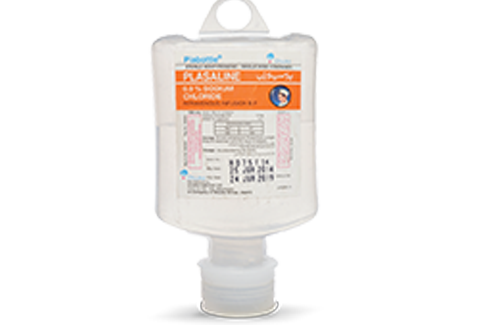
Standard Solutions -Plasa line
(0.9% Sodium Chloride Intravenous Infusion B.P.) (Normal Saline)
Therapeutic Class
Isotonic crystalloid salt solution
Description and Composition
A clear, colorless solution each 1000 ml. of which contains:
| Sodium Chloride B.P. | 9.0 grams |
| Water for Injections | q.s. |
Indications
- Trauma
- Hypovolemic states such as prolonged vomiting.
- Environmental emergencies
- Diabetic ketoacidosis.
- H.H.N.C.
- Useful for dilution of medications, as a flushing agent for rapid I.V. medication administration, and irrigation solution for eyes, wounds, and bladder wash after prostate surgery.
- Can be used in children to keep vein open.
- Management of hypercalcemia.
Dosage and Administration
Plasaline should be administered according to the clinical condition of the patient, age, and body weight.
Diabetic ketoacidosis (DKA) and hyperglycemic, hyperosmolar, non-ketotic coma (H.H.N.C.) may require 500 – 1000mL/hour if blood glucose is greatly elevated and patients are hypotensive and/or dehydrated.
Duration of Action and Excretion
Passes out of the bloodstream quite rapidly, especially when normal renal function and renal blood flow are present.
Adverse Effects
- Fluid overload and congestive heart failure.
- Edema.
- Electrolyte imbalance.
- Hyperchloremic acidosis.
- Hypertension.
Contraindications
- Congestive heart failure.
Precautions
- Care is required in those cases where salt intake is restricted, such as in hypertensive patients.
- In patients where sodium losses exceed chloride losses, it can cause hyperchloremia and hyperchloremic acidosis.
- Infusion of large volumes may cause dilutional acidosis due to the dilution of the bicarbonate concentration in the plasma.
- Care is required in conditions where hypokalemia and/or hypocalcemia exists or may arise.
- Caution should be exercised in patients with renal failure and in those with reduced urinary output.
- Continuous infusion of Plasaline may cause hypernatremia, unless free water is supplied along with it.
- Monitor E.C.G. continuously.
- Frequently monitor vital signs.
- Frequently auscultate breath sounds for rales.
Tonicity and Osmolarity
Isotonic solution having a tonicity of 150.
Isosmotic solution (308 mOsm/L)
Caloric Value
Nil
Pharmaceutical Precautions
- Normal Saline is compatible with almost all drugs.
- Store at room temperature. Protect from sunlight.
- Do not use if bottle is leaking, solution is cloudy, or contains foreign matter.
- Discard unused portion.
- Keep all medicines out of the reach of children.
Packaging
100ml in polyolefin plastic bottles with Specific Pilfer Proof Filter (SPPF) Cap.
500ml and 1000ml in Plabottle.
Pharmacological Effects
- Expands circulating volume by approximating sodium content of the blood.
- Each liter provides 150 mEq of sodium and 150 mEq of chloride.
- The pH range is 3.5 - 7.5.

